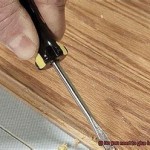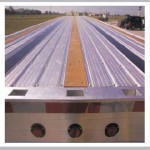Installing Transition Strips: Laminate Flooring to Carpet
Transition strips are essential components in flooring installations where two different flooring types meet. These strips provide a seamless and aesthetically pleasing transition, while also preventing tripping hazards and protecting the edges of the flooring materials. A common scenario involves transitioning from laminate flooring to carpet, which requires a specific type of transition strip and careful installation techniques to ensure durability and a professional finish.
This article provides a detailed guide on how to install transition strips between laminate flooring and carpet. It encompasses the necessary tools and materials, step-by-step instructions, and crucial considerations for a successful installation. The focus is on providing clear and practical advice enabling homeowners and professionals to achieve a high-quality result.
Before commencing the installation process, it is paramount to accurately assess the requirements of the transition. This includes measuring the width of the doorway or opening where the transition will occur, noting the height difference between the laminate and carpet, and selecting the appropriate type of transition strip. These preliminary steps are critical for ensuring a smooth and lasting transition.
Preparation: Gathering Tools and Materials
Successful installation of a transition strip requires having the right tools and materials readily available. The following is a comprehensive list:
1. Transition Strip: Select a transition strip specifically designed for laminate-to-carpet transitions. These typically feature a sloping profile that accommodates the height difference and a mechanism for securing the carpet edge. Common materials include aluminum, wood, and vinyl, each offering varying degrees of durability and aesthetic appeal. The chosen material should complement the existing flooring and décor.
2. Measuring Tape: Essential for accurately measuring the width of the opening and determining the length of the transition strip required.
3. Saw: A miter saw or hand saw with a fine-tooth blade is needed to cut the transition strip to the correct length. A miter saw provides more precise and cleaner cuts, particularly for metal strips.
4. Pencil: For marking the cutting line on the transition strip.
5. Drill or Screwdriver: Depending on the type of transition strip and the subfloor material, a drill with appropriate drill bits or a screwdriver may be necessary for securing the strip. Some strips come with pre-drilled holes, while others require drilling pilot holes.
6. Hammer: A hammer might be required for gently tapping the transition strip into place, especially if it utilizes a snap-in or friction-fit installation method.
7. Utility Knife or Carpet Knife: Used to trim the carpet edges for a clean and neat appearance around the transition strip. A sharp blade is crucial for preventing fraying and ensuring a professional finish.
8. Tack Strip (Optional): In some cases, replacing or supplementing the existing tack strip near the transition can improve carpet grip and prevent unraveling. Ensure the new tack strip is the appropriate height and securely fastened to the subfloor.
9. Construction Adhesive (Optional): Provides additional adhesion between the transition strip and the subfloor, particularly useful for uneven surfaces or high-traffic areas. Select an adhesive compatible with both the transition strip material and the subfloor. Liquid Nails or similar products are often suitable.
10. Safety Glasses and Gloves: Essential personal protective equipment for protecting eyes and hands during the installation process, especially when cutting and drilling.
11. Vacuum Cleaner: To remove debris and dust from the installation area both before and after the transition strip is installed. This ensures a clean surface for adhesion and a professional-looking finish.
Step-by-Step Installation Process
With the necessary tools and materials gathered, the installation process can begin. The following steps provide a detailed guide for installing a transition strip between laminate flooring and carpet:
1. Measure and Cut the Transition Strip: Accurately measure the width of the doorway or opening where the transition strip will be installed. Transfer this measurement to the transition strip, marking the cutting line with a pencil. Use a miter saw or hand saw to cut the strip to the correct length. Ensure the cut is clean and straight for a professional appearance.
2. Prepare the Carpet Edge: Carefully trim the carpet edge using a utility knife or carpet knife. The goal is to create a clean, straight edge that aligns with the laminate flooring. Remove any excess carpet fibers or padding that might interfere with the transition strip. Consider replacing the tack strip if it is damaged or not providing sufficient grip.
3. Position the Transition Strip: Place the transition strip in the desired location, ensuring it aligns properly with both the laminate flooring and the carpet edge. The sloping profile of the strip should smoothly transition from the higher level of the laminate to the lower level of the carpet. Adjust the position until you achieve the desired aesthetic and functionality.
4. Secure the Transition Strip: The method for securing the transition strip will vary depending on the type of strip selected. Some strips utilize screws that are driven directly into the subfloor through pre-drilled holes. Others may rely on a snap-in mechanism or require the use of construction adhesive. For strips with pre-drilled holes, drill pilot holes into the subfloor to prevent splitting and ensure a secure hold. If using construction adhesive, apply a thin bead to the underside of the strip before positioning it in place. For snap-in strips, carefully align the components and press them together until they lock securely.
5. Fine-Tune the Installation: Once the transition strip is secured, inspect the installation for any gaps or unevenness. Use a hammer to gently tap the strip into place if necessary. Trim any remaining carpet fibers or adjust the position of the strip to achieve a seamless transition. Ensure the carpet is securely tucked beneath the transition strip to prevent unraveling. Vacuum the area to remove any debris or dust.
6. Finishing Touches: After the main installation, a few finishing touches can significantly improve the overall appearance and durability of the transition. Consider applying a bead of caulk along the edges of the transition strip where it meets the laminate flooring. This will create a watertight seal and prevent moisture from seeping underneath. Also, periodically inspect the transition strip for any signs of wear or damage. Tighten any loose screws or reapply adhesive as needed to maintain its integrity.
Key Considerations for a Successful Transition
Achieving a successful transition between laminate flooring and carpet involves careful attention to detail and consideration of various factors. The following key points highlight crucial aspects to consider:
1. Height Difference: The height difference between the laminate flooring and the carpet is a critical factor in selecting the appropriate transition strip. The chosen strip should have a sloping profile that effectively bridges the gap and creates a smooth transition. If the height difference is significant, a wider transition strip may be necessary. Consider adding a thin layer of underlayment beneath the carpet to minimize the height difference if possible.
2. Subfloor Material: The subfloor material will influence the method used to secure the transition strip. For concrete subfloors, drill pilot holes and use concrete screws. For wood subfloors, wood screws are typically sufficient. If the subfloor is uneven or damaged, consider using construction adhesive to provide additional support and stability. Ensure the chosen adhesive is compatible with both the transition strip material and the subfloor.
3. Traffic Level: The amount of foot traffic in the area where the transition strip is installed will impact the durability and longevity of the installation. In high-traffic areas, consider selecting a transition strip made from a durable material such as aluminum or hardwood. Ensure the strip is securely fastened to the subfloor to prevent it from loosening or becoming damaged over time. Regularly inspect the transition strip and make any necessary repairs to maintain its integrity.
4. Aesthetic Consistency: Selecting a transition strip that complements both the laminate flooring and the carpet is essential for achieving a cohesive and aesthetically pleasing look. Consider the color, finish, and style of the strip to ensure it blends seamlessly with the existing flooring. Sample transition strips can be helpful in visualizing the final result before making a purchase.
5. Codes and Regulations: It is essential to verify any particular local codes and regulations that may pertain to flooring transitions, especially in commercial settings or public spaces. These codes may specify requirements for slip resistance, accessibility, and fire safety. Ensuring compliance with these regulations is crucial for safety and legal reasons.
By carefully considering these factors and following the detailed instructions outlined in this article, individuals can successfully install transition strips between laminate flooring and carpet, creating a safe, functional, and visually appealing transition.

Install Clip For Transition Strip Diy Carpet Laminateflooring Flooring Homeimp Laying Laminate Installing Installation

Carpet To Laminate Transition

Laminate Floor Transition To Carpet How Install Mryoucandoityourself

Installing Transitions Against Carpet Doityourself Com Community Forums

Pin On New Home Ideas

How To Install Carpet Transition Trim Between Vinyl Interior Design Wonderhowto

How To Transition Flooring Best Floor Transitions 50

Tile And Carpet To Laminate Transition Bunnings Work Community

Laminate To Carpet Transition Options Doityourself Com Community Forums Tile Flooring Wood

How To Install A T Molding Glue Down
Related Posts








